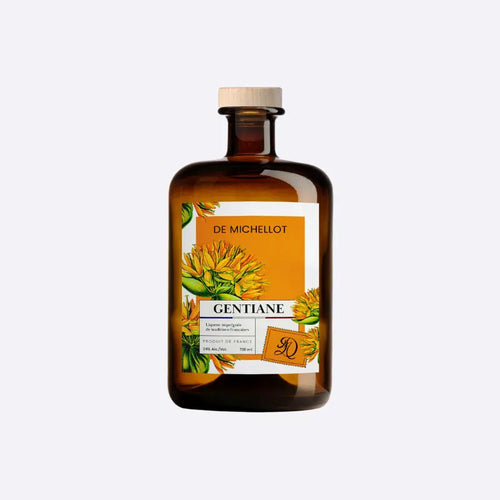Gentian liqueur: the story of a treasure from the French mountains
An emblematic plant of the French mountains , gentian is much more than just a plant. For centuries, it has been at the heart of a unique artisanal skill: the production of gentian liqueur . A natural remedy, an aperitif with bitter notes, a cultural marker of the Massif Central... this is the fascinating history of gentian in France.
What is gentian?
Yellow gentian (Gentiana lutea) is a perennial plant that grows between 800 and 2,500 meters above sea level, mainly in the Massif Central, the Alps and the Pyrenees. Known for its powerfully bitter roots , it is traditionally used in herbal medicine to stimulate the appetite and aid digestion.
An ancestral medicinal plant
Since ancient times, gentian has been recognized for its medicinal properties . It takes its name from Gentius, king of Illyria, who is said to have discovered its therapeutic properties. Valued for its tonic and digestive effects, gentian root is used in decoction, maceration... and then distillation.
The birth of gentian liqueur
Auvergne, cradle of tradition
It is in the heart of Auvergne, on the high volcanic plateaus, that gentian liqueur finds its letters of nobility. In the 19th century, farmers picked the wild root to make homemade aperitifs , based on maceration in alcohol. Production was initially domestic, then industrialized over time.
A tradition passed down from generation to generation
Recipes are passed down through families or between artisan distillers. Each region and producer develops their own recipe for gentian liqueur , sometimes adding mountain herbs, bark, or spices to balance the bitterness.
Gentian and popular culture
A plant part of the rural landscape
Gentian is part of the daily life of many families in Auvergne, where its harvest is sometimes regulated to preserve resources. It symbolizes the harshness of the climate , the authenticity of local products and the attachment to nature .
Brands that have become cult
In the 20th century, several popular brands emerged and made gentian liqueur more accessible to the general public. But behind the big labels, a multitude of artisanal producers perpetuate the tradition , with more complex, less sweet, and often more intensely flavored recipes.
The artisanal renaissance of gentian
In recent years, gentian liqueur has seen a resurgence of interest, driven by the appeal of artisanal spirits and authentic flavors . Enthusiasts are rediscovering the aromatic richness of this plant, its unique character, and its ability to enhance a cocktail or round off a good meal as a digestif.
At De Michellot , we perpetuate this heritage with an artisanal gentian liqueur , cold-macerated, without artificial flavors, according to a recipe that pays homage to the Auvergne tradition. A frank, bitter, elegant taste - gentian in all its nobility.
How to taste gentian liqueur?
-
Pure , very fresh, as an aperitif or digestif
-
Lengthened with a tonic or sparkling water , for a refined bitter tonic
-
In a cocktail , combined with gin, lemon or vermouth, for original creations
In summary
| Element | Detail |
|---|---|
| Name | Gentian liqueur |
| Origin | Auvergne, Massif Central, France |
| Plant used | Gentiana lutea (yellow gentian) |
| Taste | Bitter, complex, herbaceous |
| Uses | Aperitif, digestif, cocktail base |
| Benefits | Natural digestive, invigorating, rich in tradition |
FAQ – Gentian Liqueur
What does gentian liqueur taste like?
It is recognizable by its pronounced bitterness , accompanied by woody, earthy and lemony notes .
What are the benefits of gentian?
It stimulates the appetite, aids digestion and tones the body.
How is gentian liqueur made?
By macerating gentian roots in a neutral alcohol, sometimes followed by sweetening or adding other plants.
What is the difference between Suze and a craft liqueur?
Suze is an industrial version of gentian liqueur, often sweeter and more standardized. A craft liqueur like De Michellot's offers a rawer and more authentic flavor profile .
